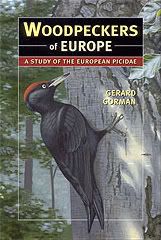Friday, 4 January 2008
Woodpeckers in Europe: status, abundance
Globally, many woodpecker species are threatened or endangered. This is also the case for some species in certain parts of Europe. This situation is largely due to the degradation, fragmentation and loss of the wooded habitats in which these birds live. The conservation of Europe’s woodpeckers is inextricably linked to the conservation of wooded habitats. Woodpeckers are good indicators of forest quality. They are indicators of forest bio-diversity, as they are often rather demanding in terms of their ecological needs. Innumerable other woodland and forest species depend upon the same ecological requirements as woodpeckers for their existence and survival. Thus, besides being worthy of protection and conservation for their own sakes, woodpeckers are highly suitable candidates for so-called “umbrella species”. That is, the study and conservation of woodpeckers and their habitats directly relates to, and invariably results in, the study of many other species of plant and animal.The study of a demanding species, family or guild defines the basic requirements for forest habitats and landscapes. However, each woodpecker species uses a given forest differently and this fact is of great use to those studying woodpeckers and to conservationists in general. Subtle changes in a forest ecosystem can be detected via the responses and trends of woodpeckers. Each woodpecker species can be regarded as an umbrella species for all those inconspicuous, and often threatened, invertebrates that inhabit the same forests. In Finland and Sweden, for example, efforts to conserve White-backed Woodpeckers habitat also means that threatened and rare beetle species are also helped as they share the same old-growth habitat. Saving the White-backed Woodpecker means saving it’s habitat and hence all the diverse species that share it. Three-toed Woodpecker, too, is a species that can act as an indicator of the presence of rare spruce bark beetles, or in other words, of the condition of old-growth boreal forest.The conservation status of Europe’s woodpeckers varies across the continent. Species which are endangered in one area, may be common elsewhere. A range of factors, both natural and unnatural, have made this so. However, in many parts of Europe the factors which determine whether certain woodpeckers occur or not, and whether they are common or not, are most certainly not natural. In a nutshell, human influence has shaped much of Europe’s wooded landscape and this influence has almost always been detrimental. As a general rule it can be taken that there are fewer woodpeckers in highly developed countries than there are in less-developed countries. In highly developed European countries greater rates of urbanisation have resulted in an overall picture composed of landscapes of inferior quality and ultimately there is less suitable woodpecker habitat. Of course, there are exceptions but the relative abundance of woodpeckers in Eastern Europe (in terms of both species and actual populations) and the relative paucity of woodpeckers in Western Europe (again, in terms of both species and actual populations) bears this out. There is no doubt that forest biodiversity in Europe has been negatively affected by the economic advances and urban developments of the last 100 years or so.
Subscribe to:
Post Comments (Atom)





No comments:
Post a Comment